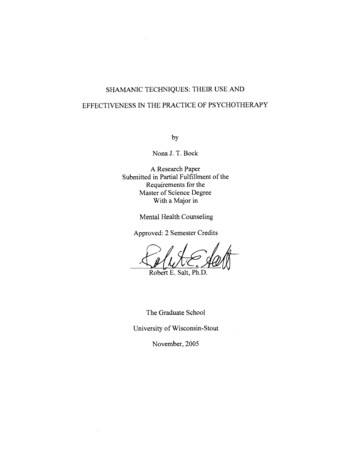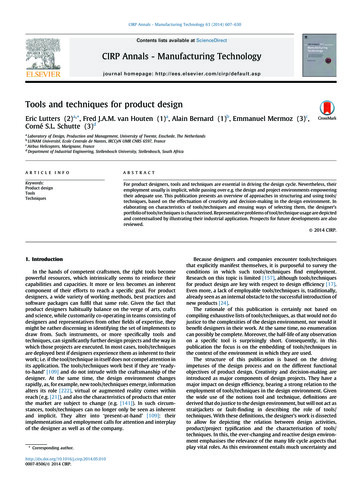
Transcription
SHAMANIC TECHNIQUES: THEIR USE ANDEFFECTIVENESS IN THE PRACTICE OF PSYCHOTHERAPYNona J. T. BockA Research PaperSubmitted in Partial Fulfillment of theRequirements for theMaster of Science DegreeWith a Major inMental Health CounselingApproved: 2 Semester CreditsThe Graduate SchoolUniversity of Wisconsin-StoutNovember, 2005
The Graduate SchoolUniversity of Wisconsin-StoutMenomonie, WIAuthor:Bock, Nona. J. T.Title:Shamanic Techniques: Their Use and Effectiveness in the Practice ofPsychotherapyGraduate DegreeMajor: MS Mental Health CounselingResearch Adviser:Robert E. Salt, Ph.D.MonthNear:November, 2005Number of Pages:152Style Manual Used: American Psychological Association, 5theditionABSTRACTThrough this research project the perspectives of 64 licensed (mental and physical healthproviders) and non-licensed practitioners who utilize shamanic techniques within their practiceswere examined with the intent to gain further knowledge and understanding in regards to the useand effectiveness of shamanic techniques within the practice of psychotherapy. A review of theliterature reveals that the ancient practice of shamanism despite the transitions in societalstructures continues to be utilized throughout the world. A number of individuals living withinthe United States have chosen to study and practice core shamanic techniques developed withinthe past few decades. As the interest in alternative healthcare in the West continues to grow, sohas the use of folk remedies, such as shamanism. Yet, even though the utilization of spiritualpractices has been demonstrated to have positive effects on health by the scientific community,the spiritual realm by its nature continues to be difficult to define and quantify, generatingcontroversy. The results of this study suggest that shamanic techniques may indeed offer an
effective means to dealing with a number of mental, physical, and spiritual concerns with certainindividuals in a relatively short period of time.
The Graduate SchoolUniversity of Wisconsin-StoutMenomonie, WIAcknowledgementsThis project would not have been possible without the support of my instructors,colleagues, husband, family, and friends.I am particularly grateful to my advisor, Dr. Bob Salt, for his ongoing open andcompassionate direction. He provided the structure to help me move forward with this project atevery step of the process, offering his knowledge, guidance, thoughtful feedback, and respectfulencouragement.I would also like to extend special thanks to each of the professors, both at the Universityof Wisconsin -Stout and at Saybrook Graduate School and Research Center, who have helpedme grow over the past two years and complete my program in Clinical Mental HealthCounseling with a concentration in Health Psychology. Gary Rockwood, Stephen Shumate,Richard Tafalla, Charles Barnard, Tem Karis, Dale Hawley, Donald Baughman, Susie Eberhard,Scott Orme, Julia Champe, and Jeanne Achterberg, your teachings and presence will not beforgotten. Each of you has been uniquely inspiring and supportive.I also offer a sincere thank you to each of my internship site supervisors, Kathy Beltramiand Wendy Limber, who so graciously extended themselves to me and offered their invaluableexperience and guidance. In addition, I want to thank the therapists and therapist trainees as wellas the other employees at each of the sites for their insightful presence.
I want to thank Lucia d'Ancona and Mary Anne Seymour who both so graciously offeredtheir computer knowledge, discernment, and friendship during the electronic survey creationprocess.My greatest heartfelt thank you is extended to my husband, Jeff Bock. This project wouldnot have been possible without your ongoing multifaceted support. I also offer a sincere thankyou to my mother and father as well as other family members who so patiently listened to meduring the creation of this project. The foundation which all of you have offered me has not onlysustained me during this process, but is something I will carry with me.I also offer a big thank you to each of the individuals who chose to take part in this study.Without you this project could not have been realized. It is my hope that the informationacquired in this study will not only help in my personal growth, but the growth of others as well.
TABLE OF ---------------------'1.Acknowledgements .111Chapter 1: Introduction .1Statement of the Problem.1Purpose of the Study.2Assumptions of the Study.2DeJinitions of Terms .3Methodology.3Chapter 11: Literature ------------------------------------ 4Shamanism: Its Definition and History------.4Shamanism as a Religion .6Shamanism as a Psychological Phenomenon.8The Shaman.*Their Call and Practice .10The Practice.14Western Psycho ogy:Its Evolution.20Aspects of Shamanism in Psychotherapy---------------------.27Jungian Analytic s y c h o o.gy28trans persona Psycho ogy.29Altered States of Consciousness-------------------.29Imagery.32
Current Day Use of Shamanic Practices.33Taking DiversiJication, Perspectives on Health and Ethical Issues into Account---------39Cultural tives on Health.42Transpersonal Psychological Ethical Issues ---44Chapter 111: Methodology.46Subject Selection ---------------------------- --47Data Collection Procedures.48Data Analysis 26Appendix A: Announcement Placed in the Society for Shamanic Practitioners Newsletter----- 135136Appendix B: Informed Consent Letter and -----Appendix C: Initial Email Request Sent March 13, 2005 ----- ------------ -.15 1
viiAppendix D: Second Email Request Sent April 16, 2
Chapter I: IntroductionAs our society has changed and evolved, so has the knowledge of the study and practiceof shamanism. Research such as that done in the realms of altered states of consciousness and therole of spirituality in health has helped to bring subjects once thought of as strictly spiritual intothe scientific realm. Today with greater diversification of our population and increased interest inalternative health care, which takes into account the whole person (body, mind, and spirit), theessential importance of exploring practices such as shamanism in regards to its use andeffectiveness becomes apparent. As core shamanic techniques are currently being offered toindividuals within the United States, many questions arise. For example, are these practicesbeing integrated with conventional psychotherapy? If so, who is doing so and how? What aretheir views of the relationship between psychotherapy and shamanism? By continuing theexploration into the evolutionary use of shamanism in today's culture within the United States,some insight may be gained to help clinicians and clients alike into the process of health andwell-being.Statement ofthe ProblemThe ancient practice of shamanism has been investigated for centuries throughout theworld. As society has changed and evolved, varied forms of the practice have been identified,created and utilized. Today in the United States licensed mental and physical health providers aswell as others utilize shamanic techniques within their practices to assist individuals in theirsearch for heath and well-being. Yet little research is available regarding the use andeffectiveness of these techniques in the practice of psychotherapy, despite the number ofindividuals offering such methods and the self-help books available on the subject to assist
individuals in their personal growth. Statistically documented evidence that quantifiably supportsthe efficacy and benefits of shamanic practices is lacking.Purpose of the StudyThrough this study, the researcher proposes to (1) gain an understanding of thedemographics of individuals who employ some form of shamanic practice, including elementssuch as age, gender, regional and occupational location, and educational background; (2) tostatistically measure the elements that influenced their decision to use shamanic techniques; (3)to identify how shamanic techniques are incorporated within a practice along with what specificmodalities the providers utilize; (4) to statistically measure the perceived effectiveness ofshamanic techniques by the practitioners who use it; (5) to determine the characteristics of theindividuals who may benefit most from this methodology; (6) to gain an understanding of whatconcerns shamanic techniques may be used to help and to statistically measure which of theseissues have the best outcome prognosis using shamanic techniques; and (7) to identify anyparticular ethical concerns that the practitioners have encountered regarding the utilization ofshamanic techniques.Assumptions of the StudyThe subjects solicited to participate in this study were identified due to their membershipwithin an organization which offers shamanic training programs or supports the philosophy andpractice shamanism. Therefore it is assumed that these participants purport some level ofeffectiveness in regards to the utilization of shamanic techniques towards the increased healthand well being of an individual.
Definition of TermsWhile controversy exists regarding the definition of shamanism, a broad workingdefinition of shamanism describes it as ". .a religious belief system in which the shaman is aspecialist in the knowledge required to make a connection to the world of the spirits in order tobring about benefits for the other members of the community (Walter, 2004, p.xv).MethodologyAs mentioned above, potential subjects were researched and identified through theirmembership within established shamanic organizations which included the Dance of the DeerFoundation Center for Shamanic Studies, Sandra Ingerman, The Foundation for ShamanicStudies, The Four Winds Society, and the Society for Shamanic Practitioners, and through wordof mouth. A 58 point questionnaire was sent to 2 16 prospective subjects either through anelectronic survey, through the mail, or via the telephone. Of these prospective subjects, 64participated in this study. The responses to this study were then analyzed by the researcherutilizing frequencies, percentages, cross tabulation, and a phenomenological qualitativeperspective.
Chapter 11: Literature ReviewWhile the subject of shamanism has been researched from a variety of perspectives,including anthropological and psychological, scholarly literature on the use of shamaniccounseling practices by mental health practitioners is limited. This literature review is intendedto explore and outline the therapeutic components of shamanism and its relationship to Westernpsychotherapy. The review begins by defining and giving a historic overview of the practice ofshamanism and then focuses on the development of Western psychological perspectives. Someof the similarities found in shamanism and Western psychotherapy are then examined. This isfollowed by a study of current day practices of shamanism and their impact in the United States.Shamanism: Its Definition and HistolyThe word shaman was first encountered among the Evenk (Tungus), a small group ofhunters and reindeer-herding people located in the Siberian forests, and derived from theTungusic word Saman (Eliade, 1964; Hamayon, 2004; Vitebsky, 1995). Among these people, theword designated a type of religious specialist; literally defined as he who knows (Hamayon,2004; Harris & Levey, 1975). The word shamanism began being introduced to literature byWestern European travelers in the eighteenth century (Hamayon, 2004). Roger Walsh (1994)defines shamanism as ". . a family of traditions whose practitioners focus on voluntarilyentering altered states of consciousness in which they experience themselves or their spirit(s)traveling to other realms at will and interacting with other entities to serve their community" (p.9)-The first accounts of Siberian forms of shamanism date back to the late seventeenthcentury when the Russian archbishop, Awakurn Petrovich, who was exiled to Siberia, describedhis experiences with a shaman in his autobiography (Hamayon, 2004; Narby & Huxley, 2001).
Yet, scholarly studies of shamanism did not begin until the late nineteenth century (Hamayon,2004). Since that time, the study of shamanism has been approached by researchers in the fieldsof anthropology, archaeology, art, gender studies, history, medicine, performances studies,psychology, and religious studies (Hamayon, 2004; Harvey, 2003). Many of these researchershave visited indigenous cultures and have watched, listened, and recorded their observations(Hamayon, 2004). Due to the influence of subjective considerations, various extra scientificapproaches have been used to research this topic. An extensive amount of research has beencompleted on shamanism fiom diverse perspectives.Shamans are considered communal leaders who are selected and taught how to work forthe community by engaging with important non-human entities (Harvey, 2003). Eliade definedshamanism as "a technique of ecstasy" (1964, p. 4). Siberia and Mongolia are considered to bethe classic shamanic areas where the ecstatic experience is considered the religious experience,but similar magico-religious phenomena has been observed in other regions of the worldincluding Eastern and Southern Asia, Central, North and South America, Africa, Australia, andelsewhere (Eliade, 1964; Vitebsky, 1995). Over time, similar ritualists encountered around theworld came to be classified as shamans and thus the word has become part of languages outsideof Siberia (Hamayon, 2004; Harvey, 2003). The term now often refers to communal leaders andreligious practitioners who locally may be designated as angakoo, bomoh, mudang, or yadgan,for example (Harvey, 2003). The word shaman has no reference to a well-established definition,but rather serves as an all-encompassing term that replaced European terms such as conjurer,diviner, healer, juggler, magician, and sorcerer, which were determined to be inadequate(Hamayon, 2004).
Today in the West, the word shaman also refers to individuals who practice withinvarious therapeutic, spiritual, and cultural movements (Harvey, 2003). By extension, the termshamanism came to be used without being delineated as a particularly scholarly concept, norlinked with any clear-cut methods (Hamayon, 2004). In addition, since the word comes from aspecific place and people, not all traditional peoples approve of the use of the word shaman as ageneric term (Vitebsky, 1995).As research progressed, two general Western ideological positions have emerged(Hamayon, 2004). These positions debate whether shamanism would be best classified as areligion, and thus a socio-cultural institution or deemed an inherent human trait to be understoodin terms of the field of psychology.Shamanism as a ReligionSharnanic practices are thought to have predated all organized religions (Wikipedia,2005). The earliest evidence of shamanism seems to date back to the Paleolithic times (Gagan,1998). This is documented by the discovery of animal skulls and bones (theorized to be shamanicritual offerings) found at sites in Europe, thought to have been inhabited between 50,000 and30,000 B.C.E. In addition, the discovery of cave sanctuaries in France and Spain along with themammoth-winter encampment in Eastern Europe by archaeologists, indicate the existence ofshamanism in the upper Paleolithic era, 15,000 to 25,000 years ago (Eliade, 1964; Walsh, 1990).Research continues to unearth drawings of such figures as deer, horses, cows, bulls. bison,rhinoceroses, lions, and owls, which are indicative of the presence of shamanic activity (Gagan,1998). Shamans were more frequently found in nomadic hunting and gathering societies andfishing societies (Krippner, 2002). As agriculture was introduced, organized religions were
created. While shamans retained their healing abilities, they lost a great deal of their power to thepriests and priestesses.It is documented that during the sixteenth century, as Europeans began exploring theWestern Hemisphere, they met with individuals in numerous communities who asserted that theycommunicated with spirits as a means to learn about life and healing (Narby & Huxley, 2001).Europeans, during this time period, believed that spirits with whom one could communicate wereconsidered evil and thus viewed these native peoples with distaste. Tens of thousands of witchesand sorcerers were being executed after imposed torture begat their confessions of havingviolated sacred Christian ceremonies, having engaged with spirits, and having made pacts withthe devil (Krippner, 2002; Narby & Huxley, 2001).During the Enlightenment period in the eighteenth century, shamans were viewed asquacks making use of others7gullibility (Hamayon, 2004). They were not theorized to fall withinthe realm of religion. Rationalist philosophers were determined to eradicate shamanism as "theirbackward ways" were viewed as an obstruction to the progress of humankind. In the frameworkof the romantic reaction against the Enlightenment, some German and French philosophers andpoets viewed shamanism favorably. Missionaries and early travelers from the West with aChristian point of view observed shamans and recognized the shaman as a religious character,but one in the service of the devil and not God (Hamayon, 2004). Such arguments were used toconvert shamanistic individuals to Christianity late into the nineteenth century. Due to theseperspectives, shamans have been frequently persecuted throughout history (Vitebsky, 1995).Eliade (1964) theorized that shamanism may be more correctly classified as mysticism than whatis commonly called a religion.
Shamanism as a Psychological PhenomenonShamans, from a psychological point of view may be "described as communitysanctioned spiritual practitioner who claims to deliberately modify their attention in an attempt toaccess information not ordinarily available to members of their social group" (Krippner, 2004, p.204). The information gained by the shaman is sought and used in an effort to improve thephysiological, psychological, and spiritual problems presented by the members of thecommunity.Changes in shamanic practices, due to the impact of and as a reaction to colonization,became apparent to scientific observers. (Hamayon, 2004) As community changes began to takeplace, incorporating a hierarchy of social and political roles, shamans could no longer defend andsustain their role, which was crucial in their previously mobile societies. Nervous and mentaltroubles increased and shamans developed healing functions as a means of symbolic protectionof their individual and collective traditional life. These healing rites were better tolerated bycolonial authorities who were focused on the development of their own law and faith. As moreindividuals took to shamanizing themselves, a variety of psychological approaches to shamanismwere created. Whereas a shaman continued to practice their traditional role in hunting andgathering tribes as well as fishing communities, the role of shamanic healer developed inagricultural societies (Krippner & Welch, 1992). This new role differed from the shaman's rolein that generally the shamanic healer had a lower social status, was less likely to have aninitiation with ceremonies and rites, less likely to communicate with spirits, led fewer p u pactivities, and was more likely to use sleight of hand in healing sessions.In the late nineteenth century as shamanism was becoming more widely used, research onshamanism moved away from the area of religion toward the field of psychology. Yet, most of
the research was done by anthropologists who had little education in psychology or psychiatry(Walsh, 1994). During this transition and throughout the first half of the twentieth century, theuse of shamanic practices was found by many to be psychopathological, with the healing powersof the rites to be used for the shamans directly as well as for those the shamans were to beattending. The shaman's personality was theorized to be the source for his or her behavior. In1935, Sergei Shirokogoroff, (Eliade, 1964) who was examining the Tungus, theorized thatshamans out of necessity must be physically and mentally strong to cope with their duties. Inaddition, he concluded that some shamans did have weak personalities.Toward the middle of the twentieth century the debate on the shaman's psychologydiminished (Hamayon, 2004). For decades, little attention was paid to the psychology ofshamanism as the shamanic tradition was not valued by psychologists (Krippner, 2002). Yet, theshaman's personality and mental states continued to be investigated during the 1970's and1980's (Hamayon, 2004). The most frequent formal diagnoses given to shamans have includedepilepsy, hysteria, and schizophrenia (Walsh, 1994). Others hypothesized that the state of mindinduced by shamanic practitioners resembled that of advanced practitioners of Buddhism, yoga,or Christian mysticism (Doore, 1988; Kalweit, 1988). Later, some saw shamanism to be neitherhere nor there and useless while others found shamanism to be an all inclusive societal system(Hamayon, 2004).During the early 1960's, while the shaman's personality was being investigated, amovement emerged in California which in time came to popularize and recreate shamanismwhile evoking greater professional and popular interest in the topic (Hamayon, 2004; Walsh,1994). This trend was impacted by two authors. First the likely fictional ethnographic writings ofCarlos Castaneda, which highlighted the use of hallucinogens as a source for enriching spiritual
life, and second, Mircea Eliade's book Shamanism: Archaic Techniques of Ecstasy, in which theperception of a direct contact with the Divine was appealing to those who contested what theyperceived as a too strict clerical hierarchy in the Christian Church (Hamayon, 2004). Shamanismbecame understood as being potentially universal; supportive of a 1 1 1 range of creative orinnovative specialties. These works helped to popularize shamanism within the counterculturemovement.This interest in shamanism spawned "Western" forms of shamanism, termed Coreshamanism or Neo-shamanism (Hamayon, 2004; Harner, 1980). Michael Harner's developmentof Core shamanism and teachings, offered through The Foundation for Shamanic Studies, hasbeen considered to have a great influence on this movement. Harner created Core shamanismthrough the incorporation of common elements found in a variety of shamanic traditions in aneffort to make shamanism more universally accessible to individuals living in the Westernculture.Over time, shamans came to be regarded by mainstream academia on a continuum frombeing "psychologically disturbed to virtual saints" with shamans being viewed as"psychologically disturbed or at best as individuals who have recovered from a significantdisturbance" (Walsh, 1994, p.8). Today, a great deal of uncertainty continues to exist regardingthe psychological health of shamans.The Shaman: Their Call and PracticeThe CallThere are various means by which an individual may be called to become a shaman.Usually the individual will encounter some sort of omen (Walsh, 1994). Most indigenoustraditions emphasize that a shaman is chosen by the spirits and that this selection is crucial
(Vitebsky, 1995). Richard No11 ( 1 987) explains that cross-culturally spirits are "subjectivelydescribed as those transpersonal forces that we experience as moving in us or through us but arenot entirely moved by us. .these [usually] personified forces or agencies are autonomous entitieswith their own agendas" (p.48).Contact with these spirits is more clearly communicated inaltered states of consciousness. Walsh (1 994) has theorized the term spirits to describe theshaman's understanding of his or her own experience and not to imply the existence of separateentities.While an individual may be recognized at birth for having the innate power to enable himor her to become a shaman, most often the call to shamanism occurs in adolescence or earlyadulthood (Vitebsky, 1995; Walsh, 1994). Others may be found later to hold a predisposition andpotential to acquire shamanic power (Vitebsky, 1995). Societal customs also play a role in theselection.One of the predominate means of becoming a shaman is through inheritance (Vitebsky,1995). At birth, an individual may be selected to carry on the family tradition (Walsh, 1994).With this early identification, a feeling of great responsibility may be experienced by theindividual, the family, and the community. In family systems with many relatives, it may not beclear which offspring should inherit the gift (Vitebsky, 1995). Persons approached by the spiritsin their dreams and visions, such as those received during a vision quest (a period of time spentfasting and in solitude in order to receive a guiding vision for one's life) may suggest that theindividual should take on the shamanic role (Vitebsky, 1995; Walsh, 1994). A mature shamanwill interpret and confirm the significance of the dream or vision (Walsh, 1994).Another means of receiving the call is by becoming sick with an illness such as epilepsy,or having an unexpected recovery from a serious disease (Vitebsky, 1995; Walsh, 1994).
Through the cause of the illness, the individual gains an understanding of the spirits' intention(Vitebsky, 1995). The individual is led to an acceptance of their new role, which allows them tobe healed and to heal others. Vitebsky (1995) states that in many regions, including Siberia,individuals.may suffer from a quite distinctive 'shamanic illness' in which they appear to goout of their minds babbling gibberish, rushing naked across the landscape with noregard for their safety, or spending weeks up a tree or lying motionless on the ground.(P. 57)Initiation through illness may take years as the individual struggles with the spirits, eventuallygiving in. The illness itself is considered a means to learning and understanding. The termwounded healer is often used to classify an individual who has been called in this way to theprofession (Bloch, 1992).Other means may include having "some striking feature or experience such as an unusualphysical appearance. .or unusual subjective experiences such as curious symptoms, feelings, andbehaviors. ." (Walsh, 1994, p. 10). Such experiences may include fainting fits, fright, beingstruck by lightening, heightened sensitivity and perception, or bizarre, dangerous, and lifethreatening behaviors (Power, 2004; Walsh, 1995).In some regions, while an individual may be chosen by the spirits, others may selectthemselves (Vitebsky, 1995, Walsh 1994). These self-selected individuals are generally regardedhowever, as less powerful. Amongst the Jivaro tribe of South America, which is considered anexception to this theory, self-selected shamanic trainees purchase their education fromestablished practitioners; acquiring the knowledge and techniques they need. Training programsin the West mirror this practice (Walsh, 1995).
The process of becoming a shaman generally incorporates an initial ecstatic orrevolutionary experience, which may be brought on by one of the aforementioned experiences
Yet, scholarly studies of shamanism did not begin until the late nineteenth century (Hamayon, 2004). Since that time, the study of shamanism has been approached by researchers in the fields of anthropology, archaeology, art, gender studies, history, medicine, performances studies, psychol










